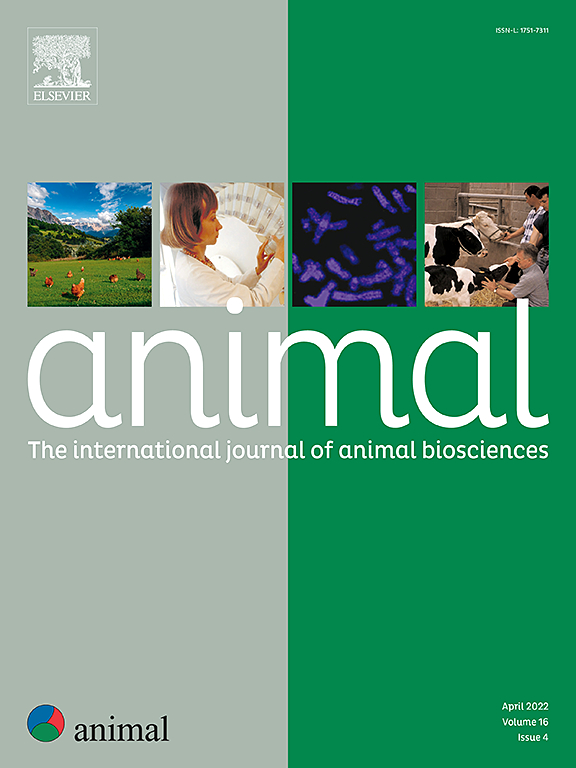The optimal isoleucine to lysine ratio in diets for postweaning piglets
IF 4.2
2区 农林科学
Q1 AGRICULTURE, DAIRY & ANIMAL SCIENCE
引用次数: 0
Abstract
Use of low CP diets for pigs contributes to an increased sustainability and reduced environmental impact of pig production. To avoid over- or undersupply of protein and essential amino acids, it is important to have more precise information on the requirement for essential amino acids in pigs in different production phases. Isoleucine (Ile) can be regarded as a potential limiting amino acid in diets for weaned piglets of today’s genotype. Therefore, the present study investigated the optimal Ile to lysine (Lys) ratio in diets for postweaning piglets in a dose−response study with 384 postweaning piglets with six dietary treatments (T1-T6) with eight replicates (pens) per treatment. Treatments included provision of diets with incremental levels of standardised ileal digestible (SID) Ile by increasing the inclusion of free L-Ile to reach a ratio of SID Ile to Lys of 37, 41, 46, 50, 55 and 60% (range 4.40 to 7.15 g SID Ile per kg of diet). The basal diet mainly consisted of corn, wheat, barley, potato protein, haemoglobin powder and soybean meal (CP: 150 g/kg; Net energy: 10.46 MJ/kg; SID Lys: 12.0 g/kg) and was supposed to be deficient in Ile (4.40 g SID Ile/kg of the diet). Daily feed intake (dFI), body weight gain (BWG) and feed conversion ratio (FCR) were measured over a period of 4 weeks, starting 6 days postweaning. Regression analysis with a broken line model and a quadratic model was applied to derive the optimal ratio of SID Ile relative to SID Lys in low−protein diets for postweaning piglets. The piglets fed the basal diet had significantly lower BWG, dFI and higher FCR (P < 0.05) than animals fed with Ile−supplemented diets. Both dFI and BWG showed a dose−dependent response towards increasing the dietary level of Ile. The optimal ratio of SID Ile to Lys, based on regression analysis with the quadratic model, was estimated at 52.6 and 52.5% for dFI and BWG, respectively. It is concluded that the optimal ratio of SID Ile relative to Lys to optimise dFI and BWG in piglets fed a low protein diet in the postweaning period is 52%.
断奶后仔猪饲粮中异亮氨酸与赖氨酸的最佳比例
猪使用低CP日粮有助于提高猪生产的可持续性和减少对环境的影响。为了避免蛋白质和必需氨基酸供应过剩或不足,掌握不同生产阶段猪对必需氨基酸需求的更精确信息是很重要的。异亮氨酸(Ile)可被视为当今基因型断奶仔猪日粮中潜在的限制性氨基酸。因此,本研究以384头断奶仔猪为试验对象,采用6种饲粮处理(T1-T6),每个处理8个重复(栏),对断奶仔猪饲粮中赖氨酸/赖氨酸(Lys)的最佳比例进行了剂量效应研究。通过增加游离L-Ile的添加量,增加饲粮中标准化回肠可消化赖氨酸水平,使回肠可消化赖氨酸与赖氨酸的比值达到37、41、46、50、55和60%(范围为4.40 ~ 7.15 g / kg饲粮)。基础饲粮以玉米、小麦、大麦、马铃薯蛋白、血红蛋白粉和豆粕为主(CP: 150 g/kg,净能:10.46 MJ/kg, SID赖氨酸:12.0 g/kg),应缺乏Ile(饲粮SID赖氨酸4.40 g/kg)。从断奶后第6天开始,在4周内测定日采食量(dFI)、体增重(BWG)和饲料系数(FCR)。采用折线模型和二次模型进行回归分析,得出断奶后仔猪低蛋白质饲粮中SID - Ile / SID - Lys的最佳比例。饲喂基础饲粮的仔猪体重增重、泌乳率显著低于添加Ile -的仔猪(P < 0.05),脂肪比显著高于添加Ile -的仔猪(P < 0.05)。dFI和BWG对日粮Ile水平的增加均表现出剂量依赖性。基于二次模型的回归分析,估计dFI和BWG的最佳SID Ile / Lys比例分别为52.6和52.5%。综上所述,断奶后低蛋白质饲粮中SID - Ile / Lys的最佳比例为52%,可优化断奶后仔猪的dFI和体重。
本文章由计算机程序翻译,如有差异,请以英文原文为准。
求助全文
约1分钟内获得全文
求助全文
来源期刊

Animal
农林科学-奶制品与动物科学
CiteScore
7.50
自引率
2.80%
发文量
246
审稿时长
3 months
期刊介绍:
Editorial board
animal attracts the best research in animal biology and animal systems from across the spectrum of the agricultural, biomedical, and environmental sciences. It is the central element in an exciting collaboration between the British Society of Animal Science (BSAS), Institut National de la Recherche Agronomique (INRA) and the European Federation of Animal Science (EAAP) and represents a merging of three scientific journals: Animal Science; Animal Research; Reproduction, Nutrition, Development. animal publishes original cutting-edge research, ''hot'' topics and horizon-scanning reviews on animal-related aspects of the life sciences at the molecular, cellular, organ, whole animal and production system levels. The main subject areas include: breeding and genetics; nutrition; physiology and functional biology of systems; behaviour, health and welfare; farming systems, environmental impact and climate change; product quality, human health and well-being. Animal models and papers dealing with the integration of research between these topics and their impact on the environment and people are particularly welcome.
 求助内容:
求助内容: 应助结果提醒方式:
应助结果提醒方式:


